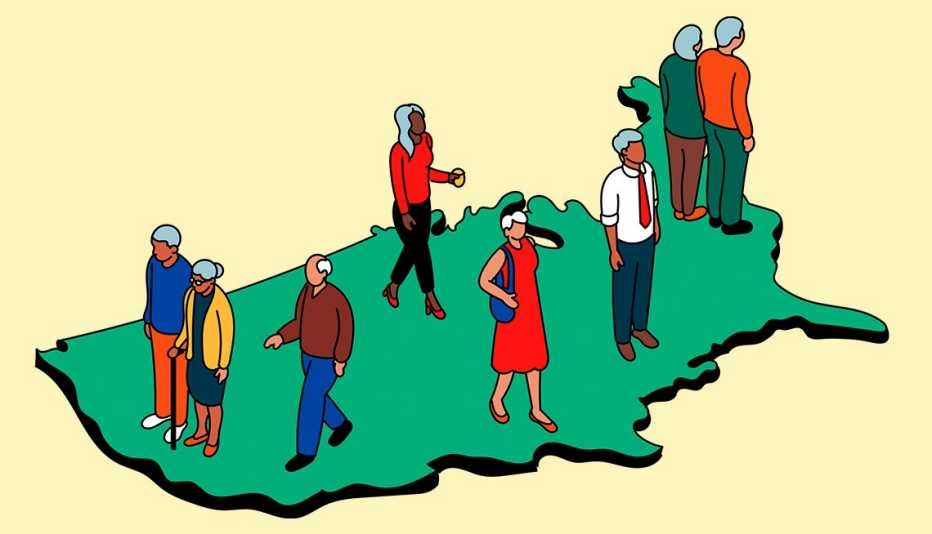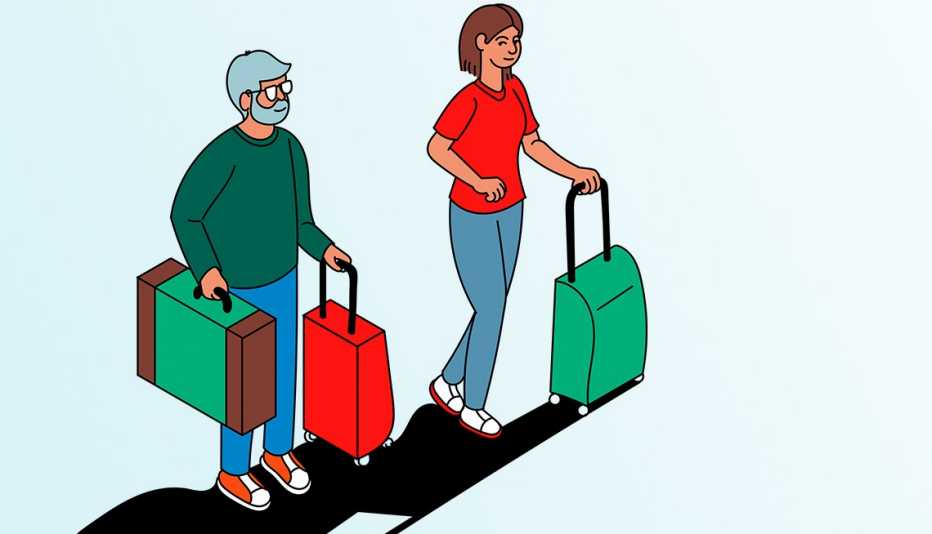AARP Hearing Center


Take a look around. We live in a country that is being transformed — in ways both obvious and hidden — by older Americans. Our growing numbers and enduring vitality ensure that this disruption will continue to roll through the American economy, culture, society and politics — penetrating deep into the very marrow of the nation.
We the people, at midlife and beyond, represent the third-largest economy in the world, after China and the U.S. as a whole. But we are more than just consumers and wealth holders: We are workers, thinkers, influencers and innovators with the power to shape markets and exert pressure on corporations and elected leaders.
And we must use that power to push for an America that is better prepared for our needs as we — and those who follow us — journey through life to old age. That’s a good story, and it’s ongoing. From work and jobs to health care and leisure pursuits, things look the way they do because of your power. And there’s more change — and a brighter future — coming for everyone. Let’s take a look at this phenomenon one sector at a time.
The Workplace


Despite decades of rampant ageism in the workplace, the number of workers 65 and older has mushroomed by 117 percent in a span of 20 years, according to the U.S. Bureau of Labor Statistics. Remarkably, employment of individuals 75 and older has increased by the same percentage.
And the trend is going strong. “I’m getting a lot of requests by employers to talk to their teams about how they can integrate older workers in their workforce,” says Janine Vanderburg, senior strategist for Changing the Narrative, a national campaign funded by the NextFifty Initiative to end ageism.
Hiring older workers is not mere altruism: An estimated 10 million jobs in America are sitting unfilled. This has forced a change in recruitment to target those of all ages, Vanderburg says. Older workers’ preference for remote work, especially in retirement, is pushing employers to be more flexible about where work happens. There are also greater opportunities for part-time work.
One company with an informal “phased retirement” program is the financial services firm Principal. Employees 57 and older with at least 10 years of service are able to transition from full-time to part-time jobs. Principal also has a “boomerang” program that allows former employees to return as part-timers. “We’re encouraging managers to engage with folks who are planning to retire and have a discussion about the parts of the job that the person really enjoys and what the needs of the company are,” says Jon Couture, Principal’s chief human resources officer.
Tax preparation firm Jackson Hewitt is increasingly hiring retirees from January through April. “We find that retirees are really great at being interactive with clients and showing empathy,” says Alicia Branon, Jackson Hewitt’s director of talent programs and attraction.
Another trend is “returnships” — short-term employment programs intended to help people who have been out of the workforce ease their way back in. Trimble, a global industrial technology company, has partnered with the nonprofit Path Forward since 2020 to offer returnships. Most participants then get full-time jobs at Trimble, the company reports.
Finally, AARP continues to expand its Employer Pledge program, in which companies commit to equal consideration of all job applicants regardless of age. Last year, 568 additional companies with a total of 1.5 million employees signed the pledge, up from 477 new signers with 1.1 million workers in 2021.
— Richard Eisenberg
Health Care


Want to see what marketplace clout looks like? Thanks to the demands of an informed, health-conscious population of older Americans, it seems like nearly every purveyor of goods or services in the U.S. is also in the health business.
At the local level, what restaurant, boutique, grocery, dry cleaner or lawn care service doesn’t cater in some way to the health and safety needs of its customers?
And it’s even more true at the national level, where big names such as Amazon, Walmart and Target are making major investments in health services and products. Older Americans spend heavily on health care, as everyone knows. In fact, it’s the only broad spending category that keeps rising with people’s ages, according to the Bureau of Labor Statistics. In 2021, boomer households spent an average of $6,600 per year on health care, and older households spent $7,050; in contrast, millennials spent at least a third less.
“More than previous generations, older people today want to be as active and healthy as possible — and the retail industry is picking up on that,” says Rachel Bonsignore, vice president at the consumer research firm GfK Consumer Life. Among retailers’ giant investments in health care: In February, Amazon dropped nearly $4 billion to purchase the primary care chain One Medical, and it rolled out prescription drug and health care membership programs.
Discount retailer Dollar General is piloting mobile health care units that roll up in front of stores for on-demand doctor appointments. This year, Walmart announced it would double the number of its Walmart Health in-store clinics in 2024.
Drugstore chain CVS is also moving beyond the pharmacy counter. At the 1,100 MinuteClinics inside CVS stores, health care practitioners trained in “age-friendly” care have joined more than 3,000 hospitals, doctors’ offices and other sites in a growing movement that focuses on older adults’ medical needs and how best to treat them, according to Terry Fulmer, president of the John A. Hartford Foundation.
The foundation, along with the Institute for Healthcare Improvement, has been working on an initiative to help older adults stay mobile, avoid risky medications, get care that matters to them, and receive help for dementia, depression and other mental health issues.
And it’s moving beyond doctors’ offices and into the places where older adults increasingly turn for health care. CVS will spend $10.6 billion on Oak Street Health to expand the retailer’s reach in underserved communities. (AARP has a relationship with Oak Street Health.)
But the ultimate in health care convenience comes in home care that rivals the excellence of hospitals such as NYU Langone. It’s a trend that is picking up steam. Since last September, 200 mostly older residents of Long Island, New York, have received hospital-level treatment for pneumonia, asthma flare-ups and other medical problems in the comfort of their own home.
“We take everything from the brick-and-mortar hospital — except the bed — and bring it home,” says Jonathan Kelly, an osteopathic physician and the medical director of NYU Langone Hospital-Long Island’s Home Hospital Program. “That includes nurses, physical therapists, supplemental oxygen, intravenous antibiotics, intensive wound care, meals planned by a dietitian if you need them, and more.”
Nearly 300 hospital-at-home programs are running in the U.S., and by 2030, an estimated 1 in 6 American hospitals will offer them, Kelly notes.
The scale of the home health care movement is huge. The consulting firm McKinsey & Company estimates $265 billion in care for Medicare beneficiaries will be delivered at home by 2025. That’s clout.
— Lisa Lee Freeman and Sari Harrar






































































More From AARP
AARP Wants to Help Your Community
Grants and fitness parks are improving life across AmericaThe Worth of Family Caregivers
Unpaid care at home is still undervalued, an AARP study finds
AARP’s Tele-Town Halls Have Brought Vital Information to Millions
Covered topics ranging from COVID-19, Medicare, prescription drugs, inflation and more